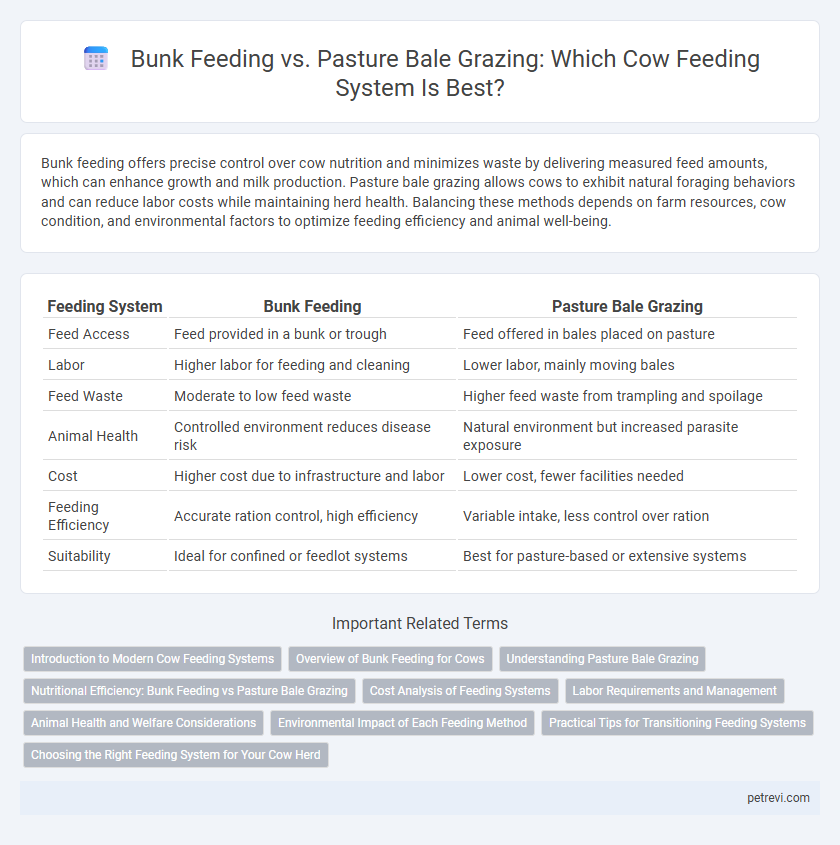Bunk feeding offers precise control over cow nutrition and minimizes waste by delivering measured feed amounts, which can enhance growth and milk production. Pasture bale grazing allows cows to exhibit natural foraging behaviors and can reduce labor costs while maintaining herd health. Balancing these methods depends on farm resources, cow condition, and environmental factors to optimize feeding efficiency and animal well-being.
Table of Comparison
| Feeding System | Bunk Feeding | Pasture Bale Grazing |
|---|---|---|
| Feed Access | Feed provided in a bunk or trough | Feed offered in bales placed on pasture |
| Labor | Higher labor for feeding and cleaning | Lower labor, mainly moving bales |
| Feed Waste | Moderate to low feed waste | Higher feed waste from trampling and spoilage |
| Animal Health | Controlled environment reduces disease risk | Natural environment but increased parasite exposure |
| Cost | Higher cost due to infrastructure and labor | Lower cost, fewer facilities needed |
| Feeding Efficiency | Accurate ration control, high efficiency | Variable intake, less control over ration |
| Suitability | Ideal for confined or feedlot systems | Best for pasture-based or extensive systems |
Introduction to Modern Cow Feeding Systems
Modern cow feeding systems integrate bunk feeding and pasture bale grazing to optimize nutrition and efficiency. Bunk feeding allows precise control over feed composition and intake, enhancing nutrient management and milk production. Pasture bale grazing leverages natural foraging behaviors, reducing labor and feed waste while maintaining animal health and productivity.
Overview of Bunk Feeding for Cows
Bunk feeding for cows involves supplying a measured amount of feed in a designated trough, allowing precise control over nutrient intake and minimizing feed wastage. This system supports efficient feed management by facilitating regular monitoring of cow consumption and health, promoting consistent growth and milk production. Bunk feeding is particularly advantageous in environments with limited grazing space or during adverse weather conditions, ensuring cows receive balanced nutrition year-round.
Understanding Pasture Bale Grazing
Pasture bale grazing is an innovative cow feeding system that involves strategically placing large bales of hay directly in pasture fields, allowing cows to graze around them while minimizing feed waste. This method supports soil health by distributing manure more evenly and reducing soil compaction compared to traditional bunk feeding systems. Pasture bale grazing also enhances cow nutrition by providing fresh forage access and reduces labor and equipment costs associated with feed distribution.
Nutritional Efficiency: Bunk Feeding vs Pasture Bale Grazing
Bunk feeding provides precise control over nutrient intake by delivering formulated rations tailored to the specific dietary requirements of cows, ensuring balanced energy and protein consumption. Pasture bale grazing offers cows access to high-fiber forage, promoting rumen health but may result in variable nutrient intake due to inconsistent bale quality and consumption patterns. Nutritional efficiency tends to be higher in bunk feeding systems due to controlled portions and nutrient-dense feed, whereas pasture bale grazing supports natural foraging behavior but may require supplementation to meet optimal production goals.
Cost Analysis of Feeding Systems
Bunk feeding systems for cows often involve higher initial infrastructure costs but can lead to more precise feed management and reduced feed wastage, potentially lowering long-term expenses. Pasture bale grazing minimizes equipment and labor costs by allowing cows to graze directly from bale placements, but may result in higher feed losses and variability in diet quality. Cost analysis indicates that bunk feeding suits operations prioritizing feed control and efficiency, while pasture bale grazing offers a low-cost alternative for extensive grazing systems with less intensive management.
Labor Requirements and Management
Bunk feeding in cow feeding systems demands higher labor input for regular feed preparation, distribution, and monitoring, ensuring precise ration control and minimizing feed wastage. Pasture bale grazing reduces labor intensity by allowing cows to self-feed on large bale placements across paddocks, yet it requires strategic bale placement and frequent movement to maintain pasture quality and prevent overgrazing. Effective management balances labor efficiency with nutritional delivery, optimizing cow health and operational cost-effectiveness.
Animal Health and Welfare Considerations
Bunk feeding provides controlled nutrition and reduces the risk of soil-borne parasites, promoting better hoof health and minimizing exposure to harsh weather conditions. Pasture bale grazing allows cows to express natural foraging behaviors, improving mental well-being and reducing stress through increased movement and social interaction. Balancing these systems optimizes animal welfare by enhancing nutritional consistency while supporting natural behaviors and overall health.
Environmental Impact of Each Feeding Method
Bunk feeding in cows often leads to concentrated manure management challenges, increasing the risk of nutrient runoff and greenhouse gas emissions, whereas pasture bale grazing promotes natural nutrient cycling and enhances soil carbon sequestration. Pasture bale grazing reduces reliance on fossil fuels by minimizing machinery use for feed transport and storage, contributing to lower overall carbon footprints. However, pasture management must be carefully planned to prevent overgrazing, which can degrade land and increase erosion, potentially offsetting environmental benefits.
Practical Tips for Transitioning Feeding Systems
Switching from bunk feeding to pasture bale grazing requires gradual adaptation to avoid digestive upset in cows. Begin by introducing small amounts of bale grazing alongside bunk feed to allow rumen microbes to adjust. Monitor cow behavior and body condition closely, ensuring adequate water and mineral supplementation during the transition period.
Choosing the Right Feeding System for Your Cow Herd
Bunk feeding and pasture bale grazing offer distinct advantages for cow herds, with bunk feeding providing precise ration control and reducing feed waste, while pasture bale grazing supports natural foraging behavior and improves pasture utilization. Selecting the best feeding system depends on factors such as herd size, pasture availability, and labor resources, ensuring optimal nutrition and animal health. Implementing a tailored approach enhances feed efficiency, promotes sustainable grazing, and reduces overall feeding costs.
Bunk Feeding vs Pasture Bale Grazing for Cow Feeding System Infographic

 petrevi.com
petrevi.com